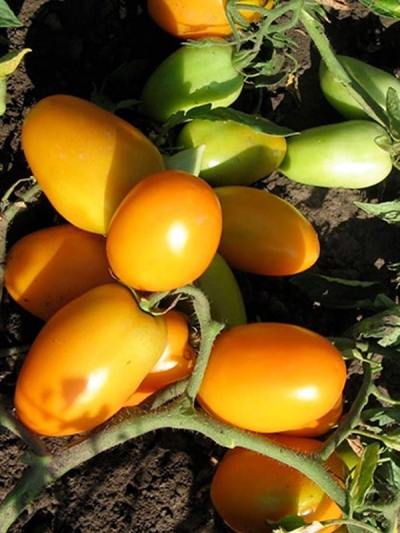
- Authors: Panchev Yu.I., Karbinskaya E.N.
- Year of approval: 2000
- Name synonyms: Golden Bullet
- Category: grade
- Growth type: determinant
- Appointment: universal
- Ripening period: mid-season
- Ripening time, days: 103-105
- Growing conditions: for open ground
- Marketable fruit yield,%: 86
The Golden Bullet tomato can be a good addition to any vegetable garden. However, it is very important to correctly apply it and take into account all the features. And the material presented to the attention of the reader will definitely help to figure it out.
Breeding history
Breeders Yu. I. Panchev and E. N. Karbinskaya were involved in the development of the culture. Its preparation was carried out in the 1990s. Official permission for gardening was given in 2000. Synonym - Golden Bullet.
Description of the variety
The golden bullet is a universal determinant culture. It is optimized for growing in open gardens. You can use it in greenhouses only at your own peril and risk. The height of the bushes reaches 0.5-0.6 m. Moderately large green leaves develop on them.
This variety is approved for cultivation in:
- Moscow region;
- Leningrad region;
- other regions of the north and center of the European part of Russia;
- central Black Earth region;
- Volga region;
- Siberian, Ural and Far Eastern regions.
The main qualities of the fruit
Freshly formed berries are green in color. When they are ripe, they will turn orange in color. The usual weight of tomatoes is 0.05 kg. In shape, they are more like a cylinder. Flawless smooth skin is typical.
Golden Bullet Tomatoes grow from simple inflorescences. The first one will appear above the 6-7 sheet. Then they go through 1-2 sheets. The peduncle has no articulation.
Taste characteristics
The flesh of the Golden Bullet is dense and strong. It has a rich taste. The scent also delights consumers. Berries contain a lot of sugar and beta-carotene. The crop can be used in both baby and diet food.
Ripening and fruiting
The Golden Bullet is a good mid-season tomato. The fruits will ripen in an average of 103-105 days. However, in some cases, weather conditions correct such a schedule. The fruit is usually harvested in July and August.
Yield
The total collection of berries reaches 2.8 kg per 1 sq. m. The share of marketable fruits is 86%. This is not the best result, but at least it is quite secured.
The timing of planting seedlings and planting in the ground
Sowing seeds in seedling containers should be between March 20 and April 10. The specific period is chosen independently, taking into account their own gardening experience, actual and predicted weather. Seedlings should be transplanted into open ground from May 15 to June 5. In the same way, all the features of a particular situation are taken into account. Most often, the required readiness for disembarkation is achieved at 60-65 days.

Growing tomato seedlings is an extremely important process, because it largely depends on whether the gardener can harvest at all. All aspects must be taken into account, from seedbed preparation to planting in the ground.
Landing scheme
The recommended landing system is 500x400 mm. Plants are supposed to form in 1-2 stems. It makes little sense to invent any other solutions.

Growing and care
The golden bullet will have to be tied up and shaped. It is recommended to drain the soil. When the first true leaves appear, it is required to dive the seedlings. The sprouts are illuminated at first. As the seedlings begin to pull out, the backlight intensity is reduced.
When 7-10 days remain before planting, tomatoes need hardening. Watering the bushes is required regularly. For this purpose, use only warm water. It is highly recommended to mix minerals with the irrigation water. It is advisable to spill the soil with a solution of vitriol before planting.
Watering involves the use of 2-3 liters of water per 1 bush. Tomatoes should be fed for the first time 14 days after planting. For this purpose, superphosphate, urea and potassium salts are mixed. The second time, an aqueous solution of chicken manure is used. Complex mixtures containing phosphorus will have to be applied for the last time in the growing season.
Despite the solid immunity of the Golden Bullet to various diseases, the seeds, the soil, and the tool used should be disinfected. Soil moisture is critical. Potatoes and other nightshade crops should not be planted nearby. For additional prevention of infections, potassium permanganate or "Fitosporin" is used. A soap solution or a decoction based on wormwood helps to scare off pests.




A plant needs different micronutrients at each stage of growth. All fertilizers can be divided into two groups: mineral and organic. Folk remedies are often used: iodine, yeast, bird droppings, eggshells.
It is important to observe the rate and period of feeding. This also applies to folk remedies and organic fertilizers.



























































































